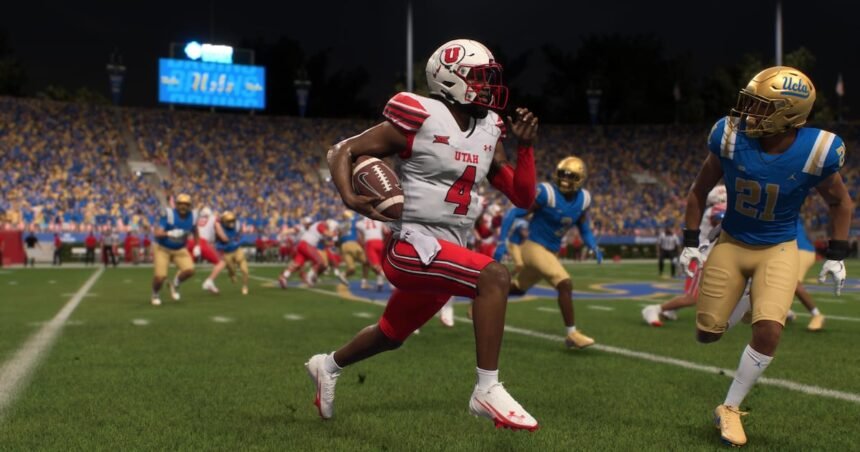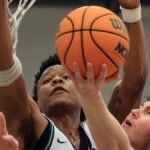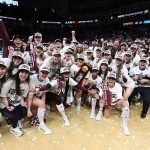EA Sports College Football 26 liked the Utah football team and Devon Dampier, until it didn’t.
That’s what I learned from an informal exercise using the newly released college football video game.
On Monday, College Football 26 — the second edition of the popular game since its revival last summer — was available to play for those who paid for a three-day early release.
That included this sports reporter, who used this early access to see how Dampier, the Utes’ new QB1, “might” fare in his first season at the power conference level.
My first task was to simulate the 2025 season for Utah and track how Dampier and the Utes’ season played out.
Perhaps the simulation was influenced by how Utah finished its 2024 campaign — the Utes lost seven straight after a 4-0 start and ended the year with a 5-7 record. In similar fashion, Utah stumbled in the back half of the simulated season.
There were some promising aspects of the simulation, though.
Key metrics for Devon Dampier in a simulated season on College Football 26
Devon Dampier’s rating in the game: 87 overall.
Passing stats: 240 of 380, 63% completion percentage, 2,610 passing yards, 19 touchdowns, 6 interceptions.
Rushing stats: 119 carries, 179 rushing yards, 3 touchdowns, 1.5 yards per carry.
Season results: 5-7 (3-6 Big 12)
- @ UCLA: W, 26-23 (2OT)
- vs. Cal Poly (FCS West on CFB 26): W, 28-7
- @ Wyoming: L, 12-10
- vs. Texas Tech: W, 13-7
- @ West Virginia: W, 38-17
- vs. No. 25 Arizona State: W, 27-13
- @ No. 7 BYU: L, 22-17
- vs. Colorado: L, 27-24
- vs. Cincinnati: L, 33-28
- @ No. 14 Baylor: L, 38-14
- vs. No. 4 Kansas State: L, 21-14
- @ Kansas: L, 26-20
Big 12 champion: Kansas State.
Big 12 participants in College Football Playoff: Kansas State (No. 4 seed), BYU (No. 8 seed).
Heisman winner: Jeremiah Smith, Ohio State wide receiver.
National champion: Miami. The Hurricanes beat Ohio State in the CFP national championship game.
What stood out
Highlight No. 1: The Utes started the year strong with a come-from-behind, double-overtime win at UCLA. Utah trailed 14-6 going into the fourth quarter, but Dampier found tight end Dallen Bentley for the 12-yard game-winning score in a second extra session in a 26-23 victory.
Dampier outdueled Nico Iamaleava, the Bruins’ new QB1.
Iamaleava completed 12 of 25 passes for 153 yards, two touchdowns and an interception, while Dampier had a better passing line, completing 21 of 28 passes for 222 yards and two touchdowns.
Highlight No. 2: Utah built off that early momentum, winning four of its first five games — including a Big 12-opening win over Texas Tech — before hosting defending Big 12 champion Arizona State.
Dampier had his best game of the year against the Sun Devils, sparking Utah to an early lead while the defense prevented Arizona State from rallying.
Dampier completed 67% of his passes against the Sun Devils for 227 yards, three touchdowns and one interception.
His two second-quarter touchdown passes gave Utah a 17-7 halftime lead, and he connected with Tobias Merriweather for a 4-yard touchdown pass with 4:33 to play to make it a two-score game.
Turning point: Unfortunately for Utah, the simulated season ended in a second straight year of not making the postseason — which would be a surprise, considering the buzz surrounding the program with a new offensive scheme in place.
The five-point loss at BYU started the skid (and Utah was ranked in the top 20 at the time), but it was a home loss to Colorado the next week that really shifted the momentum.
The Utes led the Buffaloes 21-0 at halftime but were outscored 27-3 in the second half.
From there, Utah struggled to finish games, even though it only had one loss that came by double-digits.
Positive signs: Last season at New Mexico, Dampier had 12 touchdown passes to go with 12 interceptions.
In the video game, he improved on that TD-to-INT ratio significantly, finishing with 19 touchdowns to six interceptions. Dampier threw for multiple touchdowns in six of the team’s games, including a pair of three-touchdown contests.
He had seven games where he didn’t turn the ball over — Dampier only lost one fumble all year — and he threw for 200 or more yards in nine of the Utes’ 12 games.
Utah was also able to surround him with a couple strong playmakers in running back Wayshawn Parker and Merriweather, transfers from Washington State and California, respectively.
Parker led the Utes with 704 rushing yards and four touchdowns to go with 143 receiving yards and two more scores, while Merriweather had a team-high 60 receptions for 866 yards and five touchdowns.
What seemed wrong: The biggest red flag in this experiment were Dampier’s paltry rushing numbers.
He ran for 1,166 yards and 19 touchdowns at New Mexico last season, but in the simulation, Dampier never had a single 20-yard carry on the year and his per-carry average was just 1.5.
That is well short of the dynamic running ability he’s shown through his first two collegiate seasons. While Dampier is making the leap to the power conference level this season, it would be a major surprise for him to struggle that badly on the ground.
In general, I’d expect some better rushing numbers from Utah with five returning starters on the offensive line — even Parker’s numbers seemed low in what should be a run-friendly offense.
Better rushing numbers could well have been the difference between a win or a loss in several of these games for Utah.











